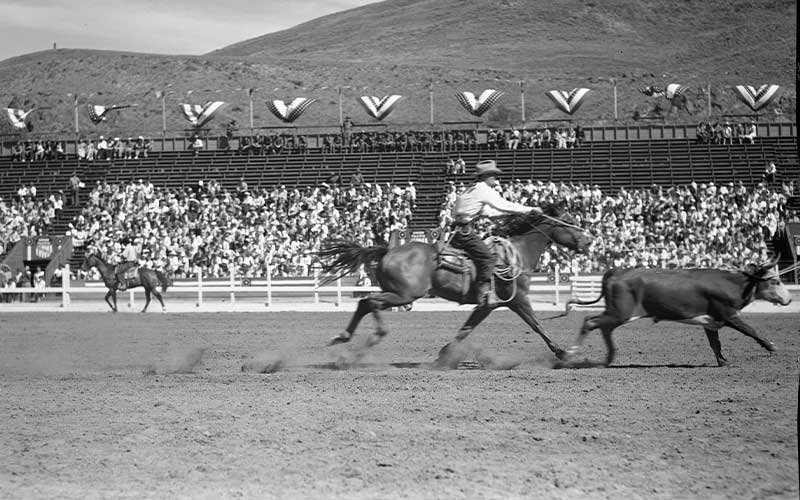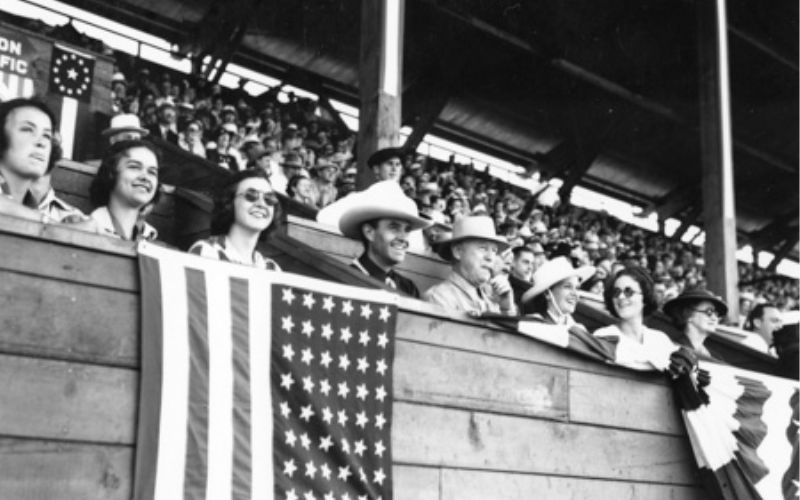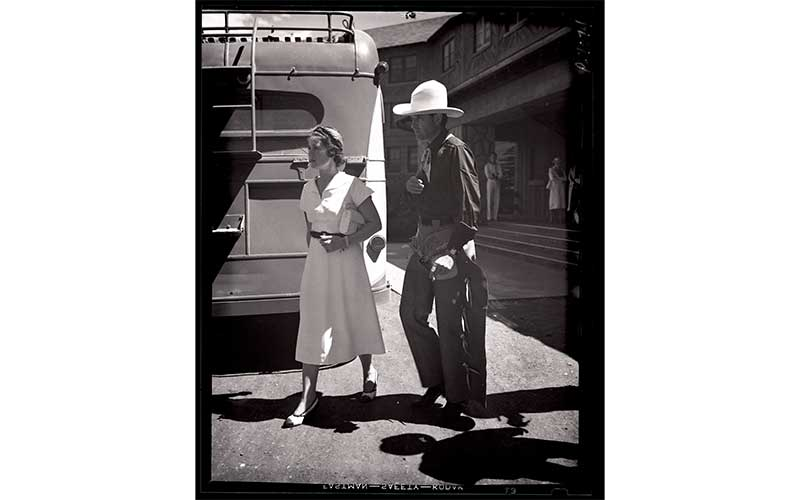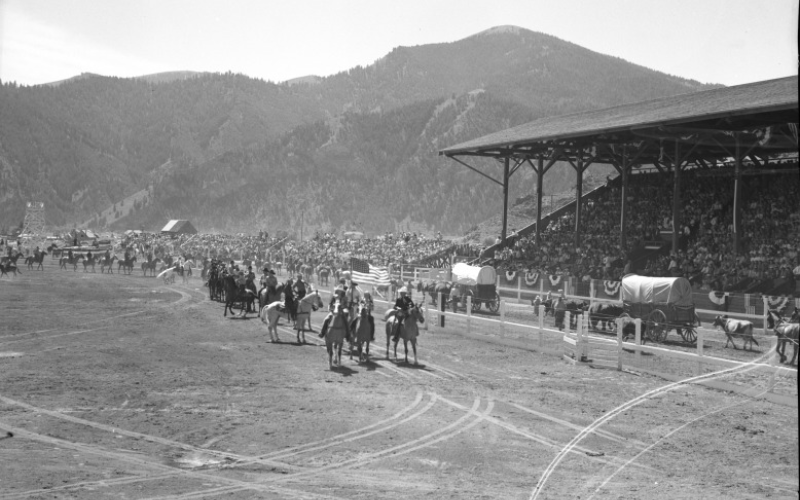|
STORY AND PHOTOS COURTESY OF JOHN W. LUNDIN Sun Valley’s rodeo, begun as a summer attraction immediately after the resort opened in 1936, was one of the resort’s most popular summer attractions before World War II. But it, along with many other activities at the resort, was shut down during World War II. As the war drug on, the Navy used the resort as a Naval Rehabilitation Hospital to treat the mental and physical wounds of 6,578 Navy, Marine and Coast Guard patients there through Dec. 1, 1945. When the war ended, Union Pacific was faced with two major dilemmas: What to with rail passenger service and whether to reopen Sun Valley Resort.
|
|

A cowboy ropes a steer at the Sun Valley Rodeo.
|
|
|
The railroad began a retreat from passenger service in 1943 when it sold to the Greyhound Company a large minority share of its two subsidiaries that provided bus travel--Union Pacific Stages and Interstate Transit. In 1952, Greyhound bought the balance of U.P.’s bus companies. Longtime board member Robert Lovett wanted to get out of the passenger business completely. However, this meant getting out of the resort business, which had been a major focus of the railroad since the 1920s at its Utah Resort Hotels and at Sun Valley. Its resorts lost money but represented a “high-profile form of advertisement and drew travelers to the road.” The issue of whether to reopen Sun Valley divided Union Pacific’s management. Averell Harriman had left Union Pacific in 1940 for public service as President’s Roosevelt’s personal envoy to England, then in charge of the Lend-Lease program for England and Russia and as the U.S. Ambassador to Russia in 1943.
|
|

Averell Harriman and friends watch the Sun Valley Rodeo.
|
|
|
He became President Truman’s Secretary of Commerce after the war, and was required to give up all management responsibilities at Union Pacific. Harriman no longer had a formal place on Union Pacific’s board, and the new president, George Ashby, favored cutting Sun Valley’s operating budget and subsidy. Harriman was kept informed of the debate and at times made his opinions known but had no direct responsibility at the railroad. Although not well known these days, Union Pacific considered not reopening Sun Valley because of $250,000 to $750,000 subsidy a year needed to cover its operations and the changing nature of railroad operations. Averell Harriman built Sun Valley to restore Union Pacific’s passenger revenue in the middle of the Great Depression, saying “we didn’t run it to make money; we ran it to be a perfect place.”
|
|

Averell Harriman liked to look the part when he attended a rodeo.
|
|
|
According to railroad historian Maury Klein, Sun Valley posed a special problem because it was a unique operation with a mood and ambiance perfectly attuned to the prewar era, and because it was Averell Harriman’s pet project. But, by 1946, the world had changed greatly. And the costs of operating Sun Valley, which had never made money under its old setup, were 50 percent higher. To restore the resort would cost a lot of money, as manager Pat Rogers itemized in a full report. Was the outlay worth it? In fall 1945, Sun Valley General Manager Pat Rogers prepared a report discussing the work necessary to bring Sun Valley back to a condition to accommodate guests in its traditional style. His report was called “Proposals and Suggestions for Post-War Purposes Covering Construction—Renovating, Decorating and Future Policies.” He discussed the requirements necessary to handle the increased volume of business to improve and maintain the reputation that Sun Valley held and offer beneficial publicity for the Union Pacific Railroad Company.
|
|

The Sun Valley Rodeo included covered wagons and cows with Baldy as a backdrop.
|
|
|
He proposed eliminating big game hunting parties, which could continue with private guides, and limit operations to bird hunting. Stables and dog kennels needed repainting and work was needed on the rodeo grounds and fencing. The River Run toboggan course needed to be re-designed to eliminate conflicts with skiers or transferred to Proctor or Ruud Mountain. The tennis courts needed resurfacing at a cost of $2,150. And paths and roadways needed maintenance. Union Pacific publicist Steve Hannagan wrote Harriman on April 2, 1946, stating that, if Union Pacific was not willing to continue its subsidy to the resort, it should not be reopened. “That it has not made money in tangible dollars and cents is perhaps less important than the fact that it has brought attention to the Union Pacific at a cost cheaper than any other known means. If it were conceived or is to be rededicated on the basis of an important money-making project, er se, it seems doomed to failure and should be liquidated immediately. But if it is to be operated with enthusiasm, foresight, affection, attention and intelligence, it can continue to set a pace for Union Pacific service, progress and acclaim--at a cost cheaper than any other vehicle of public presentation. “If we are not prepared to subsidize the endeavor, as an advertising, good will and business projecting endeavor, to the extent of $350,000 to $500,000 annually, it should be abandoned...However, it must be done with flair, enthusiasm and acknowledgment of the service it performs. The necessary expenditures could be part of the advertising budget, business entertainment and public relations along our vast rightaway, which would make it an inexpensive project.”
Hannagan suggested changes at Sun Valley so it would operate on a more streamlined basis, at less cost and higher operating profit. Summer operations had the same value as winter ones, he said. The rodeo could be eliminated and Sun Valley could be operated as a deluxe dude ranch. “Union Pacific somewhat reluctantly reopened Sun Valley in December 1947 with Pat Rogers in charge. Arthur Stoddard became president of Union Pacific in 1949, remaining until 1965 when he left after the sale of Sun Valley to the Janss Company. Harriman was critical of the way Stoddard ran Union Pacific, saying that after the war, the railroad was no longer interested in Sun Valley. “I would never have approved him as president because I didn’t think he had...the breadth or vision which I thought the Union Pacific should have in being part of the whole West and the development of the West.”
Railroad passenger business continued to decline after the war, dropping 33 percent in 1946, with the loss of military traffic, and another 61 percent by 1949, due to increased use of automobiles, trucks and air travel. This made Union Pacific’s subsidy of Sun Valley increasingly hard to swallow, leading to significant cuts in services. Stoddard adopted an austerity program with a goal of cutting Sun Valley’s $500,000 yearly loss. This led to the resignation of Pat Rogers in 1952, who disagreed with Stoddard’s management philosophy. The Sun Valley rodeo continued for several years after World War II. In summer, 1947, Native Americans from Fort Hall paraded around the grandstand tracks to entertain the crowd. Union Pacific President Ashby is shown at one post-war rodeo In summer 1948, the Baltimore Colts professional football team trained at Sun Valley for a month, following the lead of the Brooklyn Dodgers baseball team the prior summer. They worked out daily at the rodeo grounds and even played an intersquad game led by quarterback Y.A. Tittle, offering locals and guests a chance to see some of the top players in the league.
The game was part of a gala Sunday affair that included rides up Bald Mountain on the ski lift in the morning, an ice carnival in the evening and a parade featuring the Idaho Falls High School Band. On Sept. 14, 1949, publicist Steve Hannagan wrote Arthur E. Stoddard, who had become Union Pacific’s president in March, about “the Sun Valley situation.” He said General Manager Rogers had done a masterful job. “He understands the western outdoors, both winter and summer, and is well liked and respected by guests and personnel. The ski school ‘wags the dog’ and, while important, it should be the Sun Valley Ski School, instead of being built around a personality.” Sun Valley’s food was “undistinguished,” he continued. Service was generally good but could be better. He also proposed that the rodeo grounds could be used in the winter for kid’s activities and a sled dog race course.
The cutbacks that Union Pacific made at Sun Valley after the war included its rodeo--little appeared about it after the late 1940s. However, rodeoing in the Wood River Valley began taking off elsewhere—and not just down in Hailey. Learn more when John W. Lundin’s three-part essay on Sun Valley rodeos continues on Eye on Sun Valley. Editor’s Note: John W. Lundin has published a handful of history books, including “Skiing Sun Valley: A History From Union Pacific to the Holdings.” His newest is “From Cheechakos to Sourdoughs: Two Ivy Leaguers’ Quest for Yukon Gold,” which he co-authored with his brother Steve about their grandfather and their grandfather’s school chum.
|